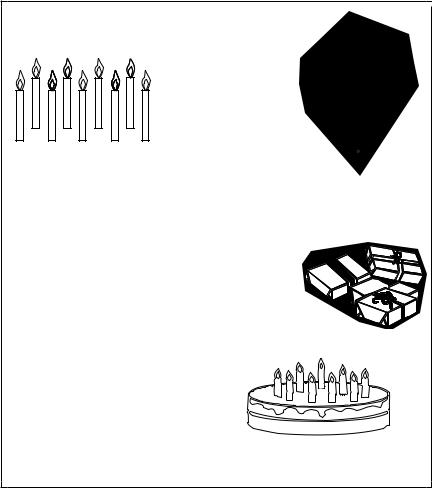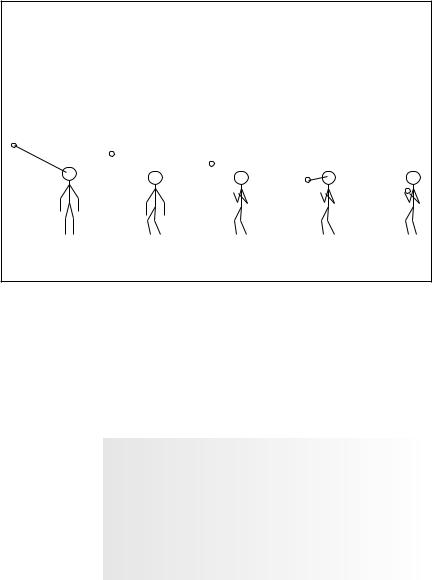

6About me
6.1My family
Level |
|
* |
Language focus |
|
Vocabulary: family members, adjectives |
Skills focus |
|
Listening for details, pronunciation: stress and rhythm |
Thinking focus |
|
Recalling |
Teaching approach |
|
Promote accuracy – correct errors |
Interaction |
|
Whole class work, suitable for large classes |
|
|
|
Note: Do not write the chant on the board. You want the children to listen carefully and repeat the chant and copy the hand movements.
Procedure
1Ask the children to stand up and shake their hands. This is to loosen up their finger muscles for a finger play. Finger plays not only tap into a kinaesthetic style of learning, but also help to develop the children’s fine motor skills.
2Tell them that you are going to teach them a finger play about families.
3Read out the first line of the finger play and demonstrate the accompanying actions. See Box 111.
4The children repeat the first line with the actions. The stressed syllables are in bold.
5Check pronunciation, stress and rhythm. Pay attention to the schwa / ə / sound on the weak syllables.
6Now read out lines 2 and 3 and ask the children to listen and repeat while following your hand actions.
7Repeat lines 1, 2 and 3 until you are satisfied that the children are saying the chant correctly and doing the hand actions.
8Now introduce lines 4, 5 and 6 and ask the children to repeat and copy the hand actions.
9Finally, perform the complete finger play together.
124

|
|
|
|
About me |
|
|
|
|
|
|
|
|
Box 111 Family finger play |
|
|
|
|
|
|
|
|
||
|
Finger play: chant |
Finger play: hand movements |
|
||
|
|
|
|
|
|
|
1 |
Mother and father standing tall. |
1 |
Show the index fingers first and |
|
|
2 |
Brother is big, |
|
then the middle fingers. Use both |
|
|
3 |
and sister is small. |
|
hands. Hold the other fingers |
|
|
4 |
Where is the baby? Where is the |
|
down with the thumb. |
|
|
|
baby? |
2 |
Show the ring fingers on both |
|
|
5 |
Wah! Wah! Wah! |
|
hands, along with the index and |
|
|
6 |
I hear him/her call! |
|
middle fingers. |
|
|
|
|
3 |
Show the little fingers. Now all |
|
|
|
|
|
fingers are showing, but the |
|
|
|
|
|
thumbs are hidden. |
|
|
|
|
4 |
Close hands into a fist and |
|
|
|
|
|
wiggle both thumbs. |
|
|
|
|
5 |
and 6 Put both hands over |
|
|
|
|
|
your ears. |
|
|
|
|
|
|
|
|
|
|
|
|
|
Follow-up
There are many well-known activities which not only promote language learning, but also assist with the development of fine motor and gross motor skills, e.g. Simon says.
6.2 My classroom
|
|
|
Level |
* |
|
Language focus |
Vocabulary: classroom objects |
|
Skills focus |
Listening for details |
|
Thinking focus |
Following directions |
|
Teaching approach |
Promote accuracy – correct errors |
|
Interaction |
Whole class work, suitable for large classes |
|
Preparation |
On small slips of paper, write the names of a number of |
|
|
familiar classroom items. Choose objects from the basic |
|
|
game. See Box 112. Jumble these and put them into a |
|
|
container. |
|
|
|
|
125

Five-Minute Activities for Young Learners
Procedure
1Ask each child to choose one object from the classroom and place it on his/her desk.
2Then ask the children to stand and listen to the names of the objects as you draw them out of the container.
3As you select a slip of paper, read out the name of the object. Anyone with this object has to sit down.
4Continue to draw out all the slips of paper one by one, and read out the name of the object. The last children left standing are the winners.
5It is possible that some children have chosen objects which you did not include in your list. If they know the English word for these items, then they win bonus points.
Box 112 Classroom objects
Classroom objects: basic game |
Classroom objects: advanced game |
|
|
Book |
Add one adjective: |
Pen |
Red pencil |
Picture |
Old toy |
Eraser |
Tennis ball |
Pencil |
Add two adjectives: |
Ruler |
New English book |
Ball |
Big picture book |
Game |
Old test book |
Toy |
|
Bag |
|
Box |
|
|
|
Follow-up
As the children become familiar with this game, they will grow more adventurous in their choice of objects. They will be motivated to check vocabulary in their dictionaries and choose unusual items in order to outsmart you. At this stage, you could choose items from the ‘advanced game’ column. Give them some warning that you will be playing the game in the near future, and this should add to their excitement and determination to be the last one standing.
126

About me
6.3 My home
|
|
|
Level |
* |
|
Language focus |
Vocabulary: ordinal numbers and household items |
|
Skills focus |
Listening for details, spelling |
|
Thinking focus |
Identifying |
|
Teaching approach |
Promote accuracy – correct errors |
|
Interaction |
Whole class work, suitable for large classes |
|
|
|
|
Procedure
1Tell the children that you are going to read out the names of some household items. You want them to write some of these words – but not all of them.
2Tell the children that you want them to write the third word in your list. See the example in Box 113. Then read out the example words from the household list and check their answers.
3Continue to read out the lists of words, giving the children time to write as you read. Make sure they understand that you do not want them to write all the words in the list, but only the ones you have indicated at the beginning, e.g. Write the second and fifth words.
4Each time, the task becomes more difficult. This is a chance for you to identify the children’s strengths and weaknesses in listening and spelling.
Box 113 Household items
Ordinal number clue |
Household list |
|
|
Example: Write the third word. |
Example: clock, TV, chair |
Write the second and fifth words. |
phone, cupboard, mat, lamp, bath |
Write the second, fourth |
bed, armchair, garden, mirror, |
and fifth words. |
bookcase, table |
Write the third, sixth, seventh |
camera, lamp, radio, bed, phone, sofa, |
and ninth words. |
window, chair, door, bath |
Write the second, fourth, fifth, |
mat, garden, bookcase, TV, clock, bed, |
eighth and tenth words. |
door, table, camera, box |
|
|
Follow-up
This activity can be adapted to include any vocabulary that you want to revise.
127

Five-Minute Activities for Young Learners
6.4 My school books
Level |
|
* |
Language focus |
|
Label, vocabulary: classroom book labelling |
Skills focus |
|
Reading and writing |
Thinking focus |
|
Recalling and naming |
Teaching approach |
|
Promote creativity – accept errors |
Interaction |
|
Whole class work, suitable for large classes |
Preparation |
|
If you have time, create label templates on your computer and |
|
|
print them onto sticky paper. Otherwise, simply write the |
|
|
label template on the board. See Box 114. |
|
|
|
Procedure
1Tell the children that they are going to create personalised labels for their English exercise books.
2Draw their attention to the six headings in the label template. See Box 114. Make sure they know the meaning of each of these headings.
3Ask the children to complete the template with their own details.
Box 114 Label template
Label template |
Completed label |
|
|
Name: . . . . . . . . . . . . . . . . . . . . . . |
Name: Tom Green |
Address: . . . . . . . . . . . . . . . . . . . . |
Address: 9 Station Road, Summerville. |
. . . . . . . . . . . . . . . . . . . . . . . . . . . . . |
|
Class: . . . . . . . . . . . . . . . . . . . . . . . |
Class: English |
Classroom: . . . . . . . . . . . . . . . . . . |
Classroom: Room 4E |
Teacher: . . . . . . . . . . . . . . . . . . . . |
Teacher: Mrs Brown |
School: . . . . . . . . . . . . . . . . . . . . . . |
School: Happy Street Primary School |
. . . . . . . . . . . . . . . . . . . . . . . . . . . . . |
|
|
|
Follow-up
•The children decorate their labels with pictures, e.g. their favourite pop group or football star.
•They could make more labels for their other subjects, so that all their class exercise books have an English label.
128

About me
6.5 My free time
|
|
|
Level |
* |
|
Language focus |
Present continuous tense |
|
Skills focus |
Speaking: pronunciation |
|
Thinking focus |
Identifying and memorising |
|
Teaching approach |
Promote accuracy – correct errors |
|
Interaction |
Small group work, suitable for large classes |
|
|
|
|
Procedure
1Divide the class into groups of three. Each person in the group has to decide on three free time activities.
2The first person mimes the three activities and then says What am I doing?
3The others have to guess the three activities and name them in the correct order. In giving their answers, they say You are . . . -ing . . . See Box 115 for some examples.
4Then the others in the group have a turn at miming while their classmates try to guess the three activities in the correct order.
5While the children are miming and guessing, go from group to group and check their pronunciation and grammar.
Box 115 Free time activities
You are: watching TV, playing computer games, riding your bike, kicking a football, playing badminton, reading a book, hitting a baseball, catching a basketball, playing with a doll, swimming in a pool, drawing a picture, singing a song, taking a photo with your camera, fishing, playing a guitar, listening to a CD, playing the piano
Follow-up
Rather than miming the free time activities, the children could draw them. The others in the group have to guess the activities from the drawings. You could give a time limit to add to the excitement of the game.
129

Five-Minute Activities for Young Learners
6.6 My mum’s mobile phone
Level |
|
* |
Language focus |
|
Text messages, the alphabet, numbers, questions |
Skills focus |
|
Writing: punctuation |
Thinking focus |
|
Analysing and discovering |
Teaching approach |
|
Promote creativity – accept errors |
Interaction |
|
Pairwork |
Preparation |
|
Write the example text message on the board. See Box 116. |
|
|
|
Procedure
1Some children will be familiar with text messaging and the short cuts that mobile phone users often use. For the others, tell them that, to save money, people shorten their text messages and use symbols instead of whole words.
2Refer the class to the example text message on the board. Ask them to solve the puzzle and read out the text message. Write the example out in full. See Box 116.
3Write another message on the board. See the text messages puzzles in Box 116.
4Ask the children, in pairs, to solve the puzzle of this text message. Ask them to write the message out in full.
5Call on pairs to share their answers with the class.
Box 116 Text messages
Text messages: puzzles |
Text messages: answers |
|
|
Example: Can U come 4 T? |
Example: Can you come for tea? |
What R U eating 4 T? Ps. |
What are you eating for tea? Peas. |
R U watching TV? Can U C me on TV? |
Are you watching TV? Can you see |
|
me on TV? |
How many letters R there? There R 2 4 |
How many letters are there? There |
U and 1 4 me. |
are two for you and one for me. |
|
|
Follow-up
•Continue with the other text message puzzles from Box 116.
•Ask the children, in pairs, to devise their own text messages using symbols. They could then ‘send’ their text message on a piece of paper and challenge their partner to solve their text message puzzle. Then the classmate writes another text message in reply.
130

|
|
About me |
6.7 My friends |
||
|
|
|
Level |
** |
|
Language focus |
Song, vocabulary: adjectives describing personal attributes, |
|
|
leisure activities |
|
Skills focus |
Speaking: fluency and rhythm |
|
Thinking focus |
Inventing |
|
Teaching approach |
Promote creativity – accept errors |
|
Interaction |
Whole class work, suitable for large classes |
|
Preparation |
On the board, write the adjectives describing personal |
|
|
attributes and leisure activities. See Box 117. Prepare a |
|
|
transparency of the song. |
|
|
|
|
Procedure
1Show the children the transparency of The friendship song in Box 117 and sing the song to them. The tune is Edelweiss from the film The Sound of Music. See the Website appendix on page 149 for an on-line link to the melody.
2Choose a name from the class and insert it instead of the name in the sample song. Write the new name onto the transparency.
3As a class, decide on four personal descriptions of this person and insert them into the song.
4Now include one of this person’s leisure-time activities in the song.
5Finally, sing the new song together.
Box 117 The friendship song
The friendship song |
Adjectives: |
Leisure activities |
|
personal attributes |
|
|
|
|
Jacky Chan, Jacky Chan, |
good, gentle, small, lucky, |
Learner of: art, sport, |
We are happy to know you. |
tall, helpful, young, sweet, |
dance, music, English |
Friendly and kind, |
smart, neat, clever, tidy, |
Player of: flute, piano, |
Gentle and wise, |
kind, bright, short, quick, |
tennis, music, games |
We are lucky to know you. |
happy, friendly, wise, nice, |
Reader of: books, |
Reader of books, may you |
thoughtful, polite |
comics, stories |
grow and learn, |
|
Watcher of: films |
Grow and learn forever. |
|
|
Jacky Chan, Jacky Chan, |
|
|
Let us be friends forever. |
|
|
|
|
|
© Cambridge University Press 2007
131

Five-Minute Activities for Young Learners
Follow-up
•When the children can confidently sing the song, get them to write a version about one of their friends. They may want to do this in pairs or small groups. Then ask them to perform their song for the class.
•For other songs, see Activities 1.5, 2.14, 5.4.
6.8 My birthday party
Level |
|
** |
Language focus |
|
Invitation, interrogatives and modals |
Skills focus |
|
Reading: language in context |
Thinking focus |
|
Predicting |
Teaching approach |
|
Promote accuracy – correct errors |
Interaction |
|
Whole class work, suitable for large classes |
Preparation |
|
Write the whole text onto a transparency or large poster. |
|
|
Have some small pieces of sticky paper handy to cover some |
|
|
of the words. |
|
|
|
Procedure
1Together read the birthday invitation.
2Jointly construct the details for the gaps, e.g. the date of the party. Write these into the invitation.
3Using pieces of sticky paper, cover the words would, when, where, can. These are the key words you want to focus on in this activity.
4Now, as a class, start to read the invitation again. Choose children to give the missing words, all the time encouraging discussion about why this word would be most suitable. When the word has been correctly identified, remove the sticky paper and read the text together.
Follow-up
•This activity is called a ‘progressive cloze’. You can use this technique with any short text. Progressively cover more and more words in the text. Choose words that you want to focus on in your teaching. These may be verbs like is, prepositions such as on, or new vocabulary.
•Encourage the children to create their own birthday invitations and decorate them.
•Display the birthday invitation template in the classroom, so that the children can use it for their own invitations.
•For other cards, letters and emails, see Activities 2.12, 4.8, 5.11, 5.15.
132

About me
Box 118 A birthday invitation
Dear . . . . . . . . . . . . . . . |
|
Would you like to come to my birthday party on . . . . . . . . . . . . . . . . . . . . . . |
(Date)? |
When does the party start? . . . . . . . . . . . . . . . . . . . . . . . . . . . . . |
|
Where is the party? . . . . . . . . . . . . . . . . . . . . . . . . . . . . . . . . . . . . |
|
Please tick here if you can come.
© Cambridge University Press 2007
133

Five-Minute Activities for Young Learners
6.9 My school excursion
Level |
|
** |
Language focus |
|
Announcement, question words |
Skills focus |
|
Listening for details, note taking |
Thinking focus |
|
Discriminating |
Teaching approach |
|
Promote accuracy – correct errors |
Interaction |
|
Pairwork, suitable for large classes |
Preparation |
|
Write the note-taking grid on the board. See Box 119. |
|
|
|
Procedure
1Tell the children that the school principal is going to read out an important announcement about an excursion and they will have to note some specific details.
2Ask the children, in pairs, to copy the note-taking grid from the board.
3Slowly and carefully, read out the announcement. Make your voice sound authoritative, so that the children get the sense that the school principal is delivering the message.
4Ask the pairs to check their answers and make changes if they think they need to.
5Call on the children to give their answers, and complete the note-taking grid on the board.
Box 119 Excursion announcement
The principal’s excursion announcement |
Note-taking grid |
|
|
Good morning, everyone. |
When? Day . . . . . . . . . . . . . |
Next Wednesday we will all go to the zoo. |
Time . . . . . . . . . . . . . . . . . . |
We will take the bus and I want you to meet |
Where? . . . . . . . . . . . . . . . . |
in the playground at 9 am. Please bring a |
Meet? . . . . . . . . . . . . . . . . . |
bottle of water, a sandwich and some fruit. |
Bring? . . . . . . . . . . . . . . . . . |
And don’t forget to wear a hat. It will be |
. . . . . . . . . . . . . . . . . . . . . . . |
quite a hot day. |
Wear? . . . . . . . . . . . . . . . . . |
Thank you, children. |
|
|
|
134

About me
Follow-up
•For future excursions or other school functions, use this activity to give the announcement and ask the children to note the details.
•School excursions also provide an excellent opportunity for both oral and written recounts.
•For other factual recounts, see Activities 1.17, 4.16, 5.14.
6.10 My sporting skills
|
|
|
Level |
** |
|
Language focus |
Procedure, imperative |
|
Skills focus |
Writing |
|
Thinking focus |
Creating |
|
Teaching approach |
Promote creativity – accept errors |
|
Interaction |
Pairwork, suitable for large classes |
|
Preparation |
Write the sample procedure on a transparency. See Box 120. |
|
|
|
|
Procedure
1Divide the class into pairs. Try to match children with similar sporting interests.
2Ask the children to think about one specific skill they need in order to be successful in their sport. It could be how to hold a bat, how to serve in tennis, or how to dive into a pool. For those who do not play a sport, encourage them to choose leisure activities like how to bait a fishing hook, or musical skills like how to hold a violin.
3Show the children the sample procedure from Box 120 and read it together.
4Ask the children to write four or five steps to describe a skill to a Martian. They should keep their sentences short and begin each sentence with the imperative form of the verb.
5Select children to read out their instructions to their classmates.
135

Five-Minute Activities for Young Learners
Box 120 How to catch a ball
1Watch the ball.
2Bend your knees.
3Hold up two hands next to your chest.
4Watch the ball all the way into your hands.
5Use both hands to catch the ball.
© Cambridge University Press 2007
Follow-up
•The children’s procedures could be decorated with pictures to illustrate the instructions and then be displayed in the classroom.
•For other procedures and instructions, see Activities 2.9, 3.4, 4.12, 4.15,
4.18, 5.8, 6.13, 6.16.
6.11 My favourite TV show
Level |
|
** |
Language focus |
|
Survey, interrogatives |
Skills focus |
|
Speaking: accuracy and fluency, listening for details |
Thinking focus |
|
Giving examples |
Teaching approach |
|
Promote accuracy – correct errors |
Interaction |
|
Pairwork, suitable for large classes |
Preparation |
|
Photocopy the survey questions and the sentence stems from |
|
|
Box 121. |
|
|
|
Procedure
1Divide the class into pairs and provide each pair with a copy of the survey form. See Box 121.
2Ask one person to start asking the questions in the survey and filling in the answers.
136

About me
3Encourage the person giving the answers to use the sentence stems in the handout.
4Circulate among the pairs, checking on accuracy and fluency.
5If you have time, get the pairs to swap roles.
Box 121 TV survey form
|
TV survey questions |
Survey answers: sentence stems |
|
||
|
|
|
|
|
|
|
1 |
What is your favourite TV show? |
1 |
My favourite TV show is . . . |
|
|
|
. . . . . . . . . . . . . . . . . . . . . . . . . . . . |
|
|
|
|
2 |
When is it on TV? |
2 |
It’s on TV on . . . |
|
|
|
. . . . . . . . . . . . . . . . . . . . . . . . . . . . |
|
|
|
|
3 |
When does it start? |
3 |
It starts at . . . |
|
|
|
. . . . . . . . . . . . . . . . . . . . . . . . . . . . |
|
|
|
|
4 |
What channel is it on? |
4 |
It’s on channel . . . |
|
|
|
. . . . . . . . . . . . . . . . . . . . . . . . . . . . |
|
|
|
|
5 |
How often do you watch it? |
5 |
I watch it every . . . |
|
|
|
. . . . . . . . . . . . . . . . . . . . . . . . . . . . |
|
|
|
|
6 |
Why do you like it? |
6 |
I like it because . . . |
|
|
|
. . . . . . . . . . . . . . . . . . . . . . . . . . . . |
|
|
|
|
|
|
|
|
|
|
|
|
|
© Cambridge University Press 2007 |
|
|
|
|
|
|
|
Follow-up
•Ask the children to give feedback about their partner to the whole class.
Draw their attention to the change from the first person to the third person, and make sure they pronounce the third person singular s when they say the verbs, e.g. She watches it every Monday.
•The children mingle in the classroom and ask five others about their viewing habits. They could then report their findings to the class, e.g.
Four out of five children watch . . . They watch it every . . . They like it because . . .
•Make graphs which represent the viewing habits of the class. Ask the children to write about the graphs. For an example of how to describe a graph, see Activity 5.17.
137

Five-Minute Activities for Young Learners
6.12 My favourite party game
Level |
|
** |
Language focus |
|
Description, relative pronoun, adverbs of time |
Skills focus |
|
Reading |
Thinking focus |
|
Locating and matching |
Teaching approach |
|
Promote accuracy – correct errors |
Interaction |
|
Whole class work |
Preparation |
|
Start with a small prize. It could be a notebook or a coloured |
|
|
pen. Wrap it in newspaper and glue one of the sentence clues |
|
|
onto the parcel. See Box 122. Wrap it again and glue on |
|
|
another sentence clue. Keep going until you have a very large |
|
|
parcel with one sentence clue glued on the top. You could |
|
|
wrap this last layer with coloured paper. |
|
|
|
Procedure
1Ask one of the children to read out the first sentence clue and then he/she gives the parcel to someone in the class.
2This child takes off one layer of paper and reads out the next clue. He/She then decides who should receive the parcel next.
3Each time that the parcel is passed, the child unwraps one layer of paper, reads out the clue to the class, and then passes the parcel to another child.
4The child who unwraps the last layer can keep the prize.
Box 122 Pass the parcel
Sentence clue: |
Sentence clue: |
Sentence clue: |
Pass the parcel to the |
Pass the parcel to the |
Pass the parcel to the |
boy/girl/person who . . . |
boy/girl/person who . . . |
boy/girl/person who . . . |
|
|
|
– is sitting next to the door. |
– likes singing. |
– always talks in class. |
– is wearing glasses. |
– enjoys playing basketball. |
– always listens to the |
– is learning how to swim. |
– likes eating bananas. |
teacher. |
– is standing up. |
– enjoys going to parties. |
– never forgets to do |
|
|
his/her homework. |
|
|
– always helps others. |
|
|
|
Follow-up
The children could make their own parcels and write their own clues. Store these in the classroom. They could then play the party game as a warm-up activity or as a reward for hard work.
138

About me
6.13 My computer class
Level ***
Language focus Instructions, prepositions, vocabulary: computer Skills focus Listening for details
Thinking focus Discriminating
Teaching approach Promote accuracy – correct errors Interaction Pairwork, suitable for large classes
Preparation On the board, write the missing words from Box 123.
Procedure
1Many children already have computer skills, so you could briefly ask them to tell you some of the things they can do with their computers.
2Ask the children to write numbers 1 to 8 on a piece of paper, leaving room to write in the missing words.
3Tell them that you are going to read out some instructions for using their computer. You want them to choose from the words on the board in order to complete the instructions. If you think your children can cope without the words on the board, then allow them to listen and complete the cloze activity without any prompts.
4Now read out the instructions at a steady pace. When you get to the first gap in the cloze exercise, say Buzz. This will indicate to the children that there is a gap in the sentence. Then say Number 1. Allow time for the children to write the missing word next to their number 1.
5Then continue reading. When you get to the next gap, say Buzz. Then say Number 2. Next to their number 2, they write the missing word.
6Continue reading until you have completed the exercise.
7Ask the children, in pairs, to compare their answers while you read the cloze activity again.
139

Five-Minute Activities for Young Learners
|
Box 123 |
Computer instructions |
|
|
|
|
|
|
|
|
Computer instructions |
Computer instructions |
|
|
|
cloze activity |
cloze answers |
|
|
|
|
|
|
|
|
– To (1) . . . . |
. . . . . . . . . . . a new file, click |
– To open a new file, click on the |
|
|
– (2) . . . . . . |
. . . . . . . . the icon. |
icon. |
|
|
– (3) . . . . . . . |
. . . . . . . your work |
– Save your work before you turn |
|
|
– (4) . . . . . . . |
. . . . . . . you turn off your |
off your computer. |
|
|
– computer. |
|
|
|
|
– Cut the picture from the file and |
– Cut the picture from the file and |
|
|
|
– (5) . . . . . . . |
. . . . . . . it (6) . . . . . . . . . . . . . . |
paste it below your sentence. |
|
|
– your sentence. |
|
|
|
|
– Do a spell check (7) . . . . . . . . . . . . . . |
– Do a spell check before you |
|
|
|
– you send the (8) . . . . . . . . . . . . . . |
send the email. |
|
|
|
Missing words: before, before, on, |
|
|
|
|
below, save, open, email, paste |
|
|
|
|
|
|
|
|
|
|
|
|
|
Follow-up
•On the board, write any new vocabulary from the cloze, and provide the meaning of these words in the children’s first language. Then ask them to write some more instructions describing what they can do on the computer, e.g. how to do a web search. Once more, provide the English words that the children need to write their instructions.
•For other procedures and instructions, see Activities 2.9, 3.4, 4.12, 4.15,
4.18, 5.8, 6.10, 6.16.
6.14 My mathematics class
Level |
|
*** |
Language focus |
|
Mathematics word problem, vocabulary: days of the week |
Skills focus |
|
Reading for gist and details |
Thinking focus |
|
Problem solving |
Teaching approach |
|
Promote accuracy – correct errors |
Interaction |
|
Pairwork, suitable for large classes |
Preparation |
|
Write a word problem on the board. See Box 124. |
|
|
|
Note: The focus of this activity is to read and comprehend. Mathematics is simply the context for the text.
140

About me
Procedure
1Divide the class into pairs and ask the children to read the word problem. They may not know all the vocabulary, but they should get the gist of the text.
2Then ask them, in pairs, to translate this word problem into a number problem. See Box 124. Encourage the pairs to talk together as they solve the problem.
3Call on the children to share their answers with the class.
Box 124 Mathematics problems
Word problem |
Number problem |
|
|
Every day, William plays marbles with his friends. |
(4 x 5) – 8 = 12 |
On Monday, Tuesday, Wednesday and Thursday |
|
William won five marbles each day. On Friday he lost |
|
eight marbles. How many marbles did he win? |
|
Jill is learning to play the piano. She has two lessons |
2 + (2 x 2) + 3 = 9 |
every week. On Mondays and Fridays she practises |
|
in the mornings and in the afternoons. On Wednesdays, |
|
Tuesdays and Thursdays she practises in the mornings. |
|
How many times does Jill play the piano each week? |
|
|
|
Follow-up
Ask the children to create other word problems to challenge their classmates.
They should write their name on a piece of paper and then write a word problem, e.g. about chickens laying eggs in the farmyard, or about children travelling on the school bus. Collect all the word problems and hand them out to everyone in the class. When the children think they have written the correct number problem, they should go to the original author and check their answer. Encourage the children to use this opportunity to recycle vocabulary, and to use their dictionaries to include new words in their word problems.
141

Five-Minute Activities for Young Learners
6.15 My science class
Level |
|
*** |
Language focus |
|
Diagram, explanation, simple present tense, time markers |
Skills focus |
|
Listening for details |
Thinking focus |
|
Following directions, interpreting |
Teaching approach |
|
Promote accuracy – correct errors |
Interaction |
|
Individual work, suitable for large classes |
Preparation |
|
Draw the life cycle template on the board. In the centre, write |
|
|
The life cycle of a frog, but leave the other circles blank. See |
|
|
Box 125. |
|
|
|
Procedure
1Tell the children that you are going to read an explanation about the life cycle of a frog. See Box 126.
2Ask them to copy the blank template of the life cycle of a frog, filling in only the central circle The life cycle of a frog. See Box 125.
3As you read the explanation, ask them to draw what they hear in the life cycle diagram. They should draw their pictures in the circles.
4Check their drawings and display them in the class.
Box 125 The life cycle of a frog
Eggs
Frog |
Tadpoles |
The life cycle of a frog
Tadpole + |
Tadpole + |
back legs + |
back legs + |
front legs + |
tail |
tail |
|
142

About me
Box 126 Explanation: How do frogs reproduce?
First, the female frog lays her eggs. Then small tadpoles hatch from the eggs. A tadpole looks like an egg with a tail. Next, the tadpole grows back legs. Then the tadpole grows front legs, but it still has a tail. Finally, the tadpole loses its tail and becomes a frog. It can leave the water and hop onto some rocks.
Follow-up
•You could use other cycles for this activity, such as the life cycle of a butterfly or the rain cycle.
•For other graphs and diagrams, see Activities 3.9, 4.13, 5.17, 5.18.
6.16 My social education class
|
|
|
Level |
*** |
|
Language focus |
Making suggestions, modal verbs, conjunctions |
|
Skills focus |
Speaking |
|
Thinking focus |
Creating |
|
Teaching approach |
Promote creativity – accept errors |
|
Interaction |
Group work, suitable for large classes |
|
Preparation |
On the board, write the words Reduce, Reuse, Recycle. Then |
|
|
write the sentence stems from Box 127. |
|
|
|
|
Procedure
1Remind the class that everybody should play a part in protecting the environment and one way to help is through limiting the amount of rubbish we generate at school and at home.
2Direct their attention to the three words on the board (Reduce, Reuse and Recycle) and explain these terms in their first language.
3Tell the children that you want them to come up with suggestions about how they could implement these environmental principles at home and at school.
4Divide the class into three groups. Allocate one of the words on the board to each group. If you have a large class, divide the children into six or nine groups, and divide the words on the board between the groups.
5Now ask the children to use the sentence stems to make suggestions about how to reduce, reuse or recycle waste. See Box 127 for some ideas.
Encourage each person in the group to make a suggestion.
6Mingle among the groups and offer praise and other suggestions.
143

Five-Minute Activities for Young Learners
Box 127 Reduce, reuse, recycle
Sentence stems |
Suggestions |
|
|
At home we could . . . |
Reduce: |
At home we should . . . |
– take our own shopping bags to the |
|
supermarket |
At school we could . . . |
– buy goods with little or no packaging |
At school we should . . . |
– say No to plastic bags |
|
Reuse: |
|
– start a compost for food scraps |
|
– use magazines and paper for school craft |
|
activities |
|
– give our old games and clothes to charity |
|
Recycle: |
|
– collect bottles, cans, and paper, cardboard |
|
and plastic containers and put them into |
|
recycling bins |
|
|
Follow-up
•Ask each group to tell the class about their suggestions. Each group could record their suggestions on a piece of card and display them in the classroom.
•Here is another activity that might be a useful preparation for the above activity. Read out a list of items and ask the children to write them down in the appropriate recycling ‘bin’. The bins are labelled: paper, plastic, glass, food scraps, aluminium cans. The list of items that are read out could include things like: a bottle, a banana skin, a newspaper, a yoghurt pot, a drink can.
•The children could create posters to promote environmentally friendly practices at their school. These could be displayed on notice boards throughout the school.
•For other procedures and instructions, see Activities 2.9, 3.4, 4.12, 4.15,
4.18, 5.8, 6.10, 6.13.
144

About me
6.17 My poetry class
|
|
|
Level |
*** |
|
Language focus |
Poem: cinquain, syllables, adjectives, verbs, adverbs |
|
Skills focus |
Writing |
|
Thinking focus |
Creating |
|
Teaching approach |
Promote creativity – accept errors |
|
Interaction |
Individual work, suitable for large classes |
|
Preparation |
Write the model cinquain on the board. See Box 128. |
|
|
|
|
Procedure
1Using the cinquain template as a guide, explain the formula for writing a cinquain. Refer to the model on the board. See Box 128.
2Make sure the children understand that each line is limited by a number of syllables. Count these syllables together. If you think this is too difficult, you could structure the cinquain according to a number of words, rather than a number of syllables.
3Ask the children to write a cinquain about their best friend.
Box 128 Cinquain
Cinquain template |
Syllables |
Model cinquain |
|
|
|
Line 1: Name of a friend |
2 syllables |
Sally |
Line 2: Adjectives describing |
4 syllables |
Sure, strong, honest |
your friend |
|
|
Line 3: Verbs which apply to |
6 syllables |
Learn, think, ride, walk, |
your friend |
|
listen |
Line 4: Adverbs which apply to |
8 syllables |
Here, near, together, |
your friend |
|
quietly |
Line 5: Similar word to line 1 |
2 syllables |
Best friend |
|
|
|
Follow-up
•The children make friendship cards. They write their cinquain onto a card and decorate it and then give the card to a friend.
•Cinquains can be written about any topic. You could choose an animal, e.g. spider; food, e.g. ice cream; a relative, e.g. sister; a sport, e.g. tennis; an aspect of nature, e.g. jungle; the weather, e.g. rainbow. Every time you want to revise some aspect of vocabulary, you could use this activity.
•For other poems and tongue twisters, see Activities 1.6, 4.5.
145

Five-Minute Activities for Young Learners
6.18 My music class
Level |
|
*** |
Language focus |
|
Narrative, simple present, present continuous |
Skills focus |
|
Writing |
Thinking focus |
|
Creating |
Teaching approach |
|
Promote creativity – accept errors |
Interaction |
|
Pairwork, suitable for large classes |
Preparation |
|
You will need a recording of ‘In the Hall of the Mountain |
|
|
King’ from Peer Gynt by Grieg. On the board, write the |
|
|
sentence stems from Box 129. |
|
|
|
Procedure
1Tell the children that you are going to play some music. This music describes the adventures of Peer Gynt (a little boy), a giant Mountain King, and the king’s trolls. You may need to explain the meaning of trolls (ogres or monsters).
2Tell the children to imagine the Hall of the Mountain King. Ask them
Will he be a kind king or an angry king?
3Draw their attention to the sentence stems on the board. Then play the music (which is five minutes in length). While the music is playing, the children are using the sentence stems to write sentences about what is happening in the story.
4The children read their sentences to their partner.
Note: Narratives are often written in the past tense, but in this case, the children are writing ‘in the present’ as the music suggests the action of the story.
Follow-up
•Ask the children to write and illustrate the Peer Gynt narrative. In this activity, they could change their simple present / present continuous tense sentences into a past tense narrative, and even include some dialogue.
•Other music which is suitable for this kind of activity includes:
The William Tell Overture by Rossini The Nutcracker by Tchaikovsky Carnival of the Animals by Saint-Saens Peter and the Wolf by Prokofiev
•For other narratives, see Activities 2.16, 3.5, 3.13, 3.14, 3.18, 4.10, 5.1.
146

About me
Box 129 The Hall of the Mountain King
Sentence stems |
Sample answers |
|
|
The Hall of the Mountain King |
The Hall of the Mountain King |
looks like . . . |
looks like a dark cave / a cave in |
|
the jungle / an underwater world / |
|
an underground planet. |
Peer Gynt is . . . into the Hall of |
Peer Gynt is climbing / looking / |
the Mountain King. |
moving / walking . . . |
The trolls are . . . |
The trolls are running / following / |
|
jumping / kicking. |
The Mountain King is . . . Peer |
The Mountain King is laughing at / |
Gynt. |
shouting at / catching / throwing a |
|
pineapple / coconut / watermelon |
|
at . . . |
|
|
147
Website appendix
These website links are correct and active at the time of going to press.
Chapter 1 Animals
Activity 1.5 To hear the melody of Old Macdonald had a farm, go to the British Council website. Go to ‘Songs’ and choose ‘Little kids’. www.britishcouncil.org/kids
Activity 1.6 To find more information about writing Haiku, go to this website: www.toyomasu.com/haiku
Activity 1.17 A song about a zoo can be found at the British Council website. Go to ‘Songs’ and choose ‘Little kids’. www.britishcouncil.org/kids
Chapter 2 Journeys
Activity 2.14 To hear this song, go to www.mudcat.org and type in ‘Galway Bay’. After the printed lyrics of the song, you can ‘Click to play’ and listen to the melody.
Activity 2.16 For further story ideas about space, go to the British Council website. Go to ‘Topics’ and choose ‘Space’. This site has stories for the children to read as well as a ‘Story maker’ where children can create their own stories. www.britishcouncil.org/kids
Activity 2.18 To hear a song about the solar system, go to the British Council website and click on ‘Easy songs’. www.britishcouncil.org/kids
Chapter 3 Fantasy and adventure
Activity 3.12 A wide range of fairy tales by Hans Christian Anderson can be found on the following website: www.hca.gilead.org.il
Activity 3.13 The children can read and listen to the complete story of Jack and the beanstalk at the British Council website. Go to ‘Stories’ and click on ‘Fairy Tales’. www.britishcouncil.org/kids
Activity 3.14 For other fairy stories, go to the British Council website. Go to ‘Stories’ and click on ‘Fairy Tales’. www.britishcouncil.org/kids
148
Website appendix
Chapter 4 The world around us
Activity 4.1 If the children have access to a computer, the following website is ideal for locating a range of countries and geographical features: www.go.hrw.com/atlas/norm_htm/world.htm
Activity 4.12 The idea for the activity Ant, person, elephant came from a website about Indonesian customs and culture: www.expat.or.id/info/games.html
Chapter 5 Healthy bodies
Activity 5.1 At the British Council website, the children can listen to the complete story of Little Red Riding Hood. There are also a number of games connected to the story. The children could retell the story using finger puppets which can be printed from the site. Go to ‘Stories’ and click on ‘Fairy Tales’. www.britishcouncil.org/kids
Activity 5.4 To hear the melody of the song I have a dog and my dog loves me, go to www.songsforteaching.com Click on ‘Song lyrics’ under ‘English: ESL – EFL – ESOL’ and choose ‘My animals’.
Chapter 6 About me
Activity 6.7 To hear the melody of this song, go to www.mudcat.org and type in ‘Edelweiss’.
149
